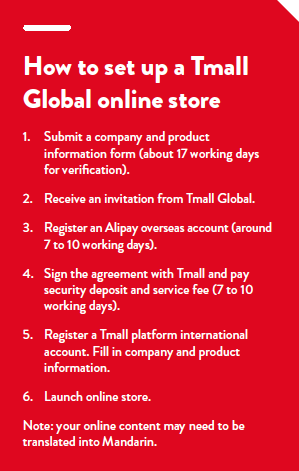e-Commerce in China

With around 632 million internet users, China is the fastest-growing and largest e-commerce market in the world. It is estimated that China's e-commerce sales make up 3.2% of the country's GDP, this is compared to 2.7% in the US. Australian businesses can take advantage of this to reach a potentially huge number of Chinese customers, even with a minimal in-country presence. Chinese government regulations do though regularly change with the possibility of restrictions being introduced in the future in this area; therefore ensure you are up to date with current legalities associated with online sales.
The number of online shoppers in China is expected to reach 350 million in 2015, and e-commerce sales are predicted to reach $840 billion by 2020. In 2014, China's National Bureau of Statistics estimates sales grew by 50% from 2013, exceeding half a trillion Australian dollars. The increasing usage of mobile phones for online shopping is a key contributor to these trends. With 520 million Chinese mobile phone internet users, online sales in China via mobile phones grew from 1.5 per cent of sales in 2011 to eight per cent in 2013.
If current trends continue, mobile payments are likely to account for 20 per cent of online transactions by 2016. To capture Chinese consumers using internet on their mobile phones, ensure you have a mobile friendly website - in Mandarin - built into your home page. Its' also strongly suggested having a China domain website which assists your page being picked up on China's leading search engine - Baidu. Top categories for online purchases include cosmetics, women’s shoes and apparel and accessories, and foreign luxury items.

How China’s e-Commerce is different
The Chinese e-commerce landscape is very different from Australia’s. Australian businesses need to adapt and tailor their offerings in China as the Chinese use different search engines and payment methods.
Some key characteristics of the Chinese e-commerce market identified by Boston Consulting Group are:
- Chinese shoppers begin their research for buying a product generally online.
- A quarter of Chinese online customers’ demand is for products consumers can’t find in physical stores.
- Social networking sites are the main form of accessing product reviews.
- Price is not everything. Many online shoppers are concerned with finding unique products that are not available offline, as well as wanting better service, convenience and the fun of the online discovery process.
- Chinese consumers buy a wider range of products online than their Western counterparts. The top five categories of purchases account for only half of the Chinese market, compared with 70 per cent in leading Western markets.
Alibaba.com is the largest e-commerce company in China. It dominates the B2B (business to business) market and its Tmall and Taobao websites also enjoy the biggest market share of the B2C (business to consumer) and C2C (consumer to consumer) markets respectively. Tmall Global allows foreign businesses without a presence in China and a Chinese business licence to create an online store and sell online in China. Australia Post recently signed an agreement with Tmall Global, specifically aimed at supporting Australian SMEs selling in China. For more information on the agreement, contact Australia Post. Other e-commerce companies in China include Jingdong, Dandang and Yihaodian.
Chinese consumers usually use local search engines, such as Baidu, rather than Google. This is due to censorship and sometimes blocking of Google content by the Chinese government firewall. As mentioned previously, many other websites familiar to Australians are not available at all in China, including Facebook, YouTube and Twitter. There are, however, Chinese equivalents that are effective channels for engaging Chinese consumers.

Online Sales Payment
Chinese consumers rarely use credit and debit cards to pay for online purchases, with cash on delivery and third party payments the most popular options. This is because of Chinese consumer concerns around credit card fraud and being sent bogus goods.
- Cash on delivery is cash, a cheque or money order payment made directly to the shipping company’s representatives when goods are delivered. This is popular in China as it allows consumers to check the quality and authenticity of products before they pay for them. Higher costs and longer wait times for payment are negatives for sellers.
- Third party payments are made through independent companies such as Alipay, Tenpay and 99Bill, which are similar to PayPal in Australia. Payment is made to the licensed third party and when both the buyer and seller are satisfied, the funds are released to the seller.
Want to learn more? Explore our other China information categories or download the China Country Starter Pack.
